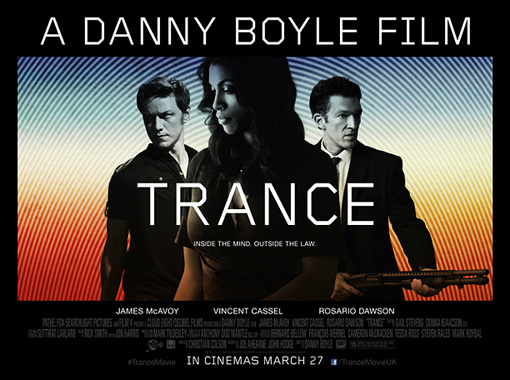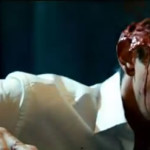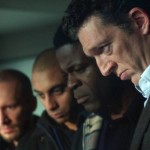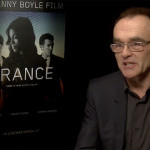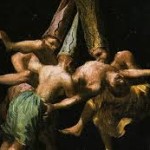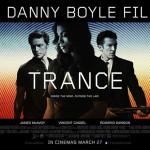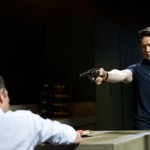Post-Olympic opening ceremony, Danny Boyle‘s stock has risen. He even turned down a knighthood but can at least make any movie he fancies. Picking and choosing his projects has not necessarily worked that well, since some of his projects have been creative in prospect but somewhat uninspiring in practice. Trance seems to have been the focus of casting off all his frustrations in one fell swoop, maybe with the intention of appealing to as diverse an audience as possible.
And boy, did Boyle chuck the kitchen sink at Trance: cod psychology & hypnotherapy, bloody gang violence, dream sequences, full-frontal nudity, a decomposing corpse, you name it! How much of the above was strictly necessary to the story is somewhat debatable, but in essence he has added some flashy and gratuitous ingredients to a fairly basic cake recipe, where maybe a simpler approach would have done the trick more effectively.
In essence Trance is the Boyle take on the art heist movie. It features James McAvoy, currently to be seen in everything except porn movies, playing an auctioneer with a gambling problem, and who therefore has his debts paid by vicious criminal gang leader Vincent Cassell in exchange for inside help to steal a Goya masterpiece from the auction room. Sensing a double-cross, Cassell’s Franck knocks out McAvoy’s Simon, causing a serious brain trauma and resulting in Simon allegedly forgetting what he did with the painting after cutting it from its frame. So Rosario Dawson‘s beautiful Harley Street hypnotherapist, Elizabeth Lamb, is employed by Franck to help him remember, though there is much more to her than meets the eye.
Except that’s far from everything going on. From the basic scenario this thriller takes off in all directions, with more twists and turns, blind alleys and red herrings than you can shake a cliché at. Almost too many for you to keep pace and complicated by the fact that McAvoy’s character is highly suggestible and therefore has both fictitious flights of fancy under the influence of hypnosis, and suppressed memories that give the movie its final denouement. The nod is towards the psychological thriller (what is real, what is not, what’s really going on in the subtext) when what it truly wants to deliver is action and violence.
McAvoy does a pretty fair job as the suave and debonair auctioneer coming apart at the seams and not in full possession of the facts of his own life, as does Dawson – who reveals all in more ways than one. The gang does its level best to look and behave thuggish without being any the wiser than the audience about the actualité.
But for me it is Cassell who hogs the limelight. He possesses charisma and screen presence like all but a few others, but uses it with sharp intelligence. Franck is a thug, but he is more than a thug. In the hands of a lesser actor this might have been a very cardboard two-dimensional character, but here he is as complex and devious as anyone, wily and more sophisticated than his appearance might suggest.
From a cinematographic perspective the movie looks absolutely gorgeous, with rich use of colour, fuzzy shots to indicate lack of mental clarity, drugs or both, plus a variety of camera angles that might be fancier than is absolutely necessary but in the context of the movie work pretty well. The special effects are impressive, though whether they actually add more than shock horror value isn’t altogether obvious.
But these days Hollywood believes in being totally explicit, with a clear expectation that ambiguity is bad and audiences want to be spoon-fed. The sort of ambiguity Boyle uses will lead a false trail, but the execs are happy because the loose ends are all tied neatly in the final reel.
Maybe this will appeal to the Boyle Trainspotting audience, but others may question whether a more Hitchcockian hinting at the terrors that lurk just behind the camera might have been more effective in building suspense. Indeed, this is where Danny could have learned a lesson or two from the master.
Hitch was a genius at tantalising the audience, and knew better than anyone that what you don’t show is more important than what you do since the imagination of the viewer is infinitely more effective a weapon to provoke emotion than any special effect. Subtlety is an undervalued art, and less truly can be more. I do hope Mr Boyle employs this weapon to good effect in his following movies.
PS. I could reveal the final twist but won’t. You may well get it for yourself, as I did, but you probably won’t spot all the plot devices used en route. Have fun!
PPS. Just so you know it’s not just me, have Jonathan Romney’s review from The Independent:
It’s probably a treasonable offence today to criticise Danny Boyle. He gladdened the hearts of nations with an Olympics opening extravaganza of flamboyance and chutzpah that also flew a flag for our endangered health service. And he’s said to be a very nice man. You could barely have a more admired public figure if you rolled PT Barnum, Ken Livingstone and Michael Palin into one.
But let me churlishly confess – I haven’t much liked any Danny Boyle film since Trainspotting, except perhaps his eccentric science-fiction venture Sunshine. It’s his very stylistic exuberance that’s the problem. Boyle is a razzle-dazzle entertainer who won’t risk the viewer being bored for a moment. He has a way of telling you, at the start of every film: settle down, get comfy in your seat because very soon, you’ll be on the edge of it. In other words: look out, I’m putting on a show.
This message is explicit at the start of the hyper-devious thriller Trance. The film begins with James McAvoy’s hero-narrator Simon explaining how the security system operates in the auction house where he works; I don’t think I’ve seen an opening that tells you quite so overtly to pay attention, because you might miss an important detail.
There’s something so knowing in Simon’s direct address to us – Boyle keeps cutting back from the action to McAvoy’s sly smirks – that your defences, and hackles, will instantly rise if you’re at all averse to being winked at.
Spoiler alerts are neither here nor there, since the plot keeps switchbacking on us every other minute. The story begins with Simon foiling the theft of a priceless Goya by a gang led by suave criminal Franck (Vincent Cassel). Only – Twist No 1 – Simon is really in league with Franck, and is due to deliver the painting to him. But – Twist No 2 – Simon has incurred a head injury and has forgotten where he put the spoils.
Once Simon has had his head tended in hospital – Trance’s one discreet plug for the NHS – he finds himself having his fingernails seen to by Franck and associates, who want to torture the booty’s whereabouts out of him.
Since this doesn’t unlock his memory, the gang presents him with a choice of psychotherapists to consult, and Simon happens to choose the sexiest one available – Harley Street specialist Elizabeth Lamb (Rosario Dawson).
It turns out she’s a wolf in Lamb’s clothing: realising what’s at stake in Simon’s amnesia, she tells Franck she wants her cut of the money, if she locates the painting. She’s prepared to do anything, she says, in Dawson’s extraordinary deep silky tones, which are Trance‘s most dazzling special effect. “You’ll fuck him to get him to remember?” says Franck, in the film’s most tongue-in-cheek exchange. “I agree,” replies Elizabeth. “It’s not conventional practice.”
In fact, there’s no remotely conventional practice to be found in the script by Joe Ahearne and long-standing Boyle collaborator John Hodge. Trancewill do whatever it takes to keep us permanently wrong-footed. Like Christopher Nolan’s Inception, it’s forever staging scenes that take place inside characters’ minds, as if they were real-world events. But Trancealso cheats by giving us shock turns of event, including sudden brutal killings, then pulling back, telling us that they never really happened – that the film is just fooling with us.
Simon is about as unreliable as a narrator can get, and his entire being serves to remind us that we’re in the realm of storytelling. Nothing wrong with that – François Ozon runs a literary riff on the premise in this week’s In the House, while Steven Soderbergh does it very nicely in Side Effects. But where Soderbergh challenges us to keep our wits peeled and question our moral assumptions about his characters and the world they move in, Trance is pure hall-of-mirrors stuff. Nothing in Boyle’s film is what it appears – so nothing matters. There’s no stable ground here – no consistent narrative or emotional rules. We can’t care about Simon if there’s nothing at stake.
One moment, the gang are terrorising him with a radical manicure, the next he’s cracking jokes with them like best buddies. Trance treats its characters as no more than game pieces. The most cavalier treatment is given to a mystery woman who at first seems a marginal bit player, then proves to have a key role; yet what happens to her is so nasty and so implausible that the revelatory shock just isn’t earned.
While the plot seems intricately contrived, the effect is of a series of for-the-hell-of-it whammies – the most shameless show-stopping effect being a novelty nude scene highlighting the, let’s say, very modern state of Dawson’s mons pubis.
What the film lacks in narrative cogency, it makes up for in colour, thanks to star cinematographer Anthony Dod Mantle: a royal blue Chinese restaurant, a purple-lit corridor, aerial shots of a fluorescent orange motorway system. There’s also much sleek use of iPads as a visual metaphor for the mind and its (mal)functions. The electric palette, the conjurer’s-flourish editing, Rick Smith’s thunderous score – it all makes for a dazzling package, but a numbing one.
Boyle’s directing often strikes me as the cinematic equivalent of 1980s pop production – you’d have liked the songs a lot better without all the reverbed drums, treated guitars and synthesisers stacked to the rafters.There’s cinematic mastery here, no doubt, but of a decidedly empty sort.The result isn’t so much trance as de luxe torpor.

